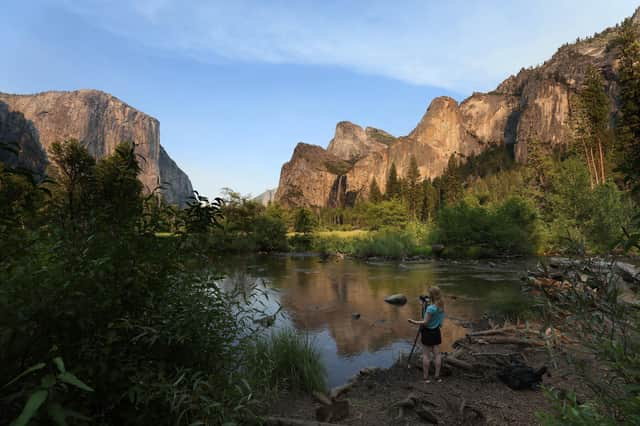What if Scotland’s new national park wasn’t only on land? – Stuart Brooks


The outcomes will help to guide the Scottish Government’s choice of the next national park, or parks, by 2026.
Scotland came late to the idea. Despite a Scotsman, John Muir, helping to pioneer them in America in the 1870s, we didn’t get one on our own land until 2003, more than half a century after the first one was established in the UK. We therefore have some catching up to do and quickly too, since national parks offer an ideal opportunity to help achieve the nation’s biodiversity and climate goals. But that requires the Scottish Government and its agencies to get their criteria and choices right.
Advertisement
Hide AdAdvertisement
Hide AdAt the National Trust for Scotland, we already know the protective power of national park status. As a conservation charity, we are fortunate to care for sites and properties in both of Scotland’s existing ones, including Ben Lomond (in the Loch Lomond and the Trossachs National Park) and the Mar Lodge Estate (in the Cairngorms National Park).
We know that being part of a park helps us to protect the unique landscapes and natural heritage in and around these sites. It also helps us to promote local economic development and share these sites with a greater number and diversity of people, in line with our strategy of ‘nature, beauty and heritage for everyone’.
So, national parks are a wonderful thing, but they could be more wonderful still. Creating a new one offers a unique option to address our climate and nature crisis and Scotland needs to make the most of the opportunity.
Firstly, there’s a strong case in Scotland to consider a coastal and marine park. England and Wales already have areas with substantial coastline; Scotland does not, despite the extent and beauty of our coasts and seas and their importance to our natural and cultural heritage. Our marine environment can be one of our most effective tools in tackling climate change, storing carbon and restoring biodiversity, yet as a nation we fall behind in protecting it.
Here at the National Trust for Scotland, we manage the protection and conservation of some of Scotland’s most treasured coastal sites and properties, from Robert Adam’s magnificent Culzean Castle, an 18th-century gem that overlooks the Firth of Clyde, to Inverewe House which offers a heritage lochside garden on the Atlantic coast, and Brodick Castle, which offers the Isle of Arran’s only country park. We also look after a number of Scotland’s coastal and island national nature reserves, including St Abb’s Head, Staffa and St Kilda, caring for some of the nation’s most beautiful locations and habitats, and the flora, fauna and sealife found in them.
Although we now have 244 marine protected areas (MPAs) in Scotland, in reality, designation alone is not a guarantee of protection. Of 31 MPAs covered by Scotland’s Marine Assessment 2020, fewer than a third had achieved their conservation objectives. The assessment also revealed that the West Highland region has lost 90 per cent of its serpulid reefs, the Hebrides 27.1 per cent of its seagrass beds and the Moray Firth 99.5 per cent of recorded blue mussel beds. The losses of these individual species highlight the severe pressures our seas face.
A coastal and marine national park, incorporating highly protected areas including no-take zones and stringent pollution controls, offers an opportunity for true protection for marine habitats and species by implementing robust management measures. This would help to restore and protect our precious seas which provide us with a range of ecosystem services such as carbon storage, flood protection, water purification, recreation, and cultural identity. It has also been proven that in the long term this approach will create opportunities for more sustainable fishing stocks.
An added benefit is that a marine and coastal location could offer a platform to highlight the importance of our seas and coasts by allowing a way for visitors to better engage with and value them, leading to economic opportunities as well as an increased understanding and action about protecting our seas.
Advertisement
Hide AdAdvertisement
Hide AdBut wherever our next national parks are sited, Scotland must be more ambitious about nature recovery. Our existing ones focus on landscape and cultural heritage protection, in contrast to the focus on nature protection in some nations.
It’s right that our national parks are places where our rural communities are supported and our cultural heritage is protected, but if Scotland is to meet its ambitions of restoring biodiversity and preventing the impacts of climate change, they should do more. They should aim to deliver for nature as well as for human activities, cultural heritage and landscape, using large-scale ecological restoration to improve the quality of our natural habitats, boost biodiversity and support ecosystem benefits such as carbon storage, fresh water, food and opportunities for recreation and well-being. Planning, regulation and management approaches should support this.
Scotland, with its wealth of remarkable landscapes and seascapes, is spoilt for choice when it comes to selecting national parks. But in making its choices, the Scottish Government has to go further, perhaps looking seawards, and certainly being more ambitious in terms of nature recovery. Our own submission to the national parks consultation prioritises these themes; we call on the Scottish Government and its agencies to do the same.
Stuart Brooks is director of conservation and policy at the National Trust for Scotland
Comments
Want to join the conversation? Please or to comment on this article.